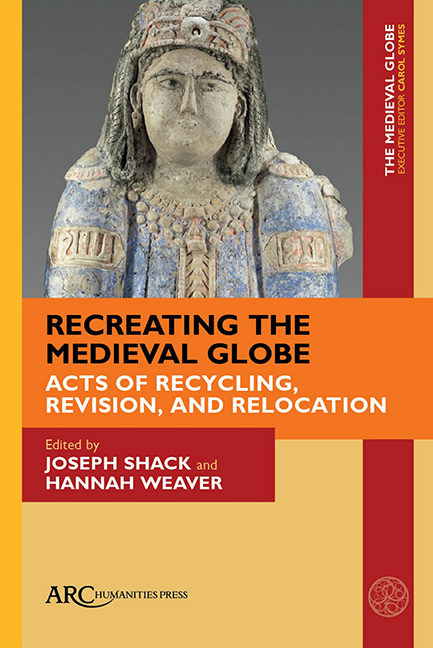Book contents
- Frontmatter
- Contents
- List of Illustrations
- Introduction to Recreating the Medieval Globe: Acts of Recycling, Revision, and Relocation
- Self-Revision and the Arabic Historical Tradition: Identifying Textual Reuse and Reorganization in the Works of al-Balādhurī
- When Curtains Fall: A Shape-Shifting Silk of the Late Abbasid Period
- Salvaging Meaning: The Art of Recycling in Sino-Mongol Quanzhou, ca. 1276–1408
- Recontextualizing Indigenous Knowledge on the Prussian–Lithuanian Frontier, CA. 1380–1410
- Meubles: The Ever Mobile Middle Ages
- Reflection
- Index
Meubles: The Ever Mobile Middle Ages
Published online by Cambridge University Press: 22 June 2021
- Frontmatter
- Contents
- List of Illustrations
- Introduction to Recreating the Medieval Globe: Acts of Recycling, Revision, and Relocation
- Self-Revision and the Arabic Historical Tradition: Identifying Textual Reuse and Reorganization in the Works of al-Balādhurī
- When Curtains Fall: A Shape-Shifting Silk of the Late Abbasid Period
- Salvaging Meaning: The Art of Recycling in Sino-Mongol Quanzhou, ca. 1276–1408
- Recontextualizing Indigenous Knowledge on the Prussian–Lithuanian Frontier, CA. 1380–1410
- Meubles: The Ever Mobile Middle Ages
- Reflection
- Index
Summary
MEUBLE, THE FRENCH word for furniture, stems from the Latin mobilis, movability being the defining characteristic of these domestic items. Relocated from castle to castle and transferred from one family member to another after the Middle Ages, furniture took on new life after the French Revolution as former family heirlooms and ecclesiastical furnishings—many of them from the medieval period—flooded the marketplace as collectibles. In this essay, I examine examples of the preservation, recycling, and repurposing of medieval meubles within a nineteenth-century French context in order to raise broader questions about the temporal and geo-spatial valence of the “Middle Ages.” Filtered through the taxonomies of reuse proposed by archaeologist Michael Schiffer, a first section focuses on new “conservatory processes” such as the “collecting behavior” that prompted figures such as Alexandre Du Sommerard, Eugène-Emmanuel Viollet-le-Duc, and Albert Jacquemart to preserve medieval furnishings while transforming their use value through display. A second section engages with what Schiffer calls “recycling”: the “remanufacture” of medieval furniture for new purposes, a process enacted by figures including Victor Hugo, Pierre Loti, and Frédéric Spitzer. A final section considers the secondary reuses of medieval furniture as emblematic of modern attitudes to the “Middle Ages” itself.
Conservatory Processes: Sacrilege and Worship
J.-K. Huysmans’ 1884 novel À rebours contains one of the best-known and most scandalous examples of nineteenth-century creative reuse of medieval furniture: his protagonist, Des Esseintes, subverts the original function of the ecclesiastical “relics” he has salvaged from Parisian and provincial antique stores and flea markets, repurposing medieval choir stalls and a pulpit to preach sermons about style. Readers found Des Esseintes’ practices sacrilegious and slipped the book into Britain in a yellow cover. They promoted it as the “breviary of the Decadence.” As fictional as the installation may seem, Des Esseintes’ reappropriation of medieval ecclesiastical furniture derives from the real-life “cathedral corner” of Baron Robert de Montesquiou de Fezensac, composed of seventeenth and eighteenth-century pieces (Figure 6.1). The nobleman later recalled having dismantled the blasphemous ensemble, donating individual pieces to a devout female friend.
How should one account for readers’ outrage over Des Esseintes’ repurposing of medieval ecclesiastical furniture when so many other contemporaries were engaged in similar activities, from transforming choir stalls into coat racks and umbrella stands, altarpiece panels into secular wall decorations, and chasubles into ladies’ coats?
- Type
- Chapter
- Information
- Recreating the Medieval GlobeActs of Recycling, Revision, and Relocation, pp. 121 - 154Publisher: Amsterdam University PressPrint publication year: 2020

